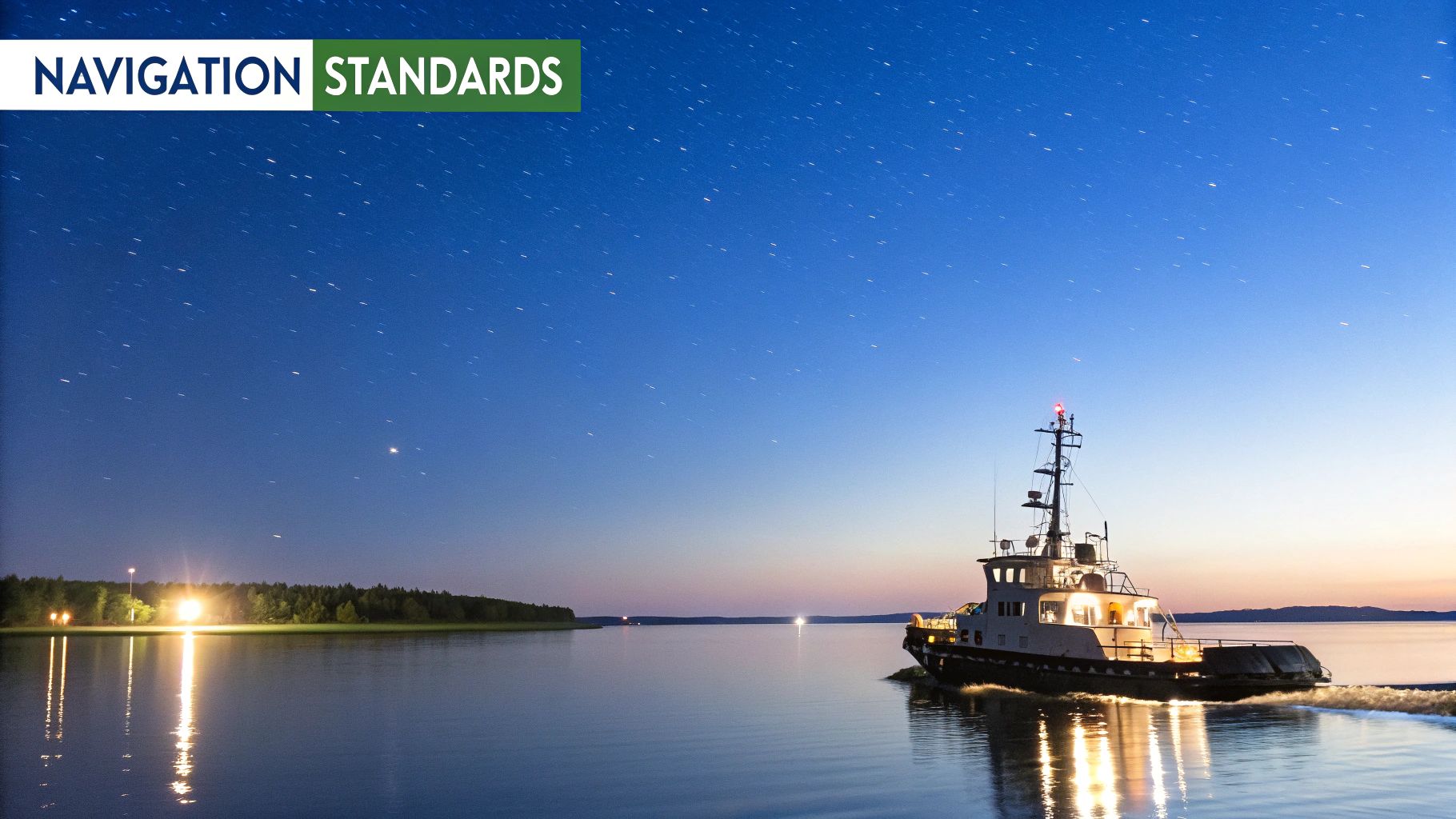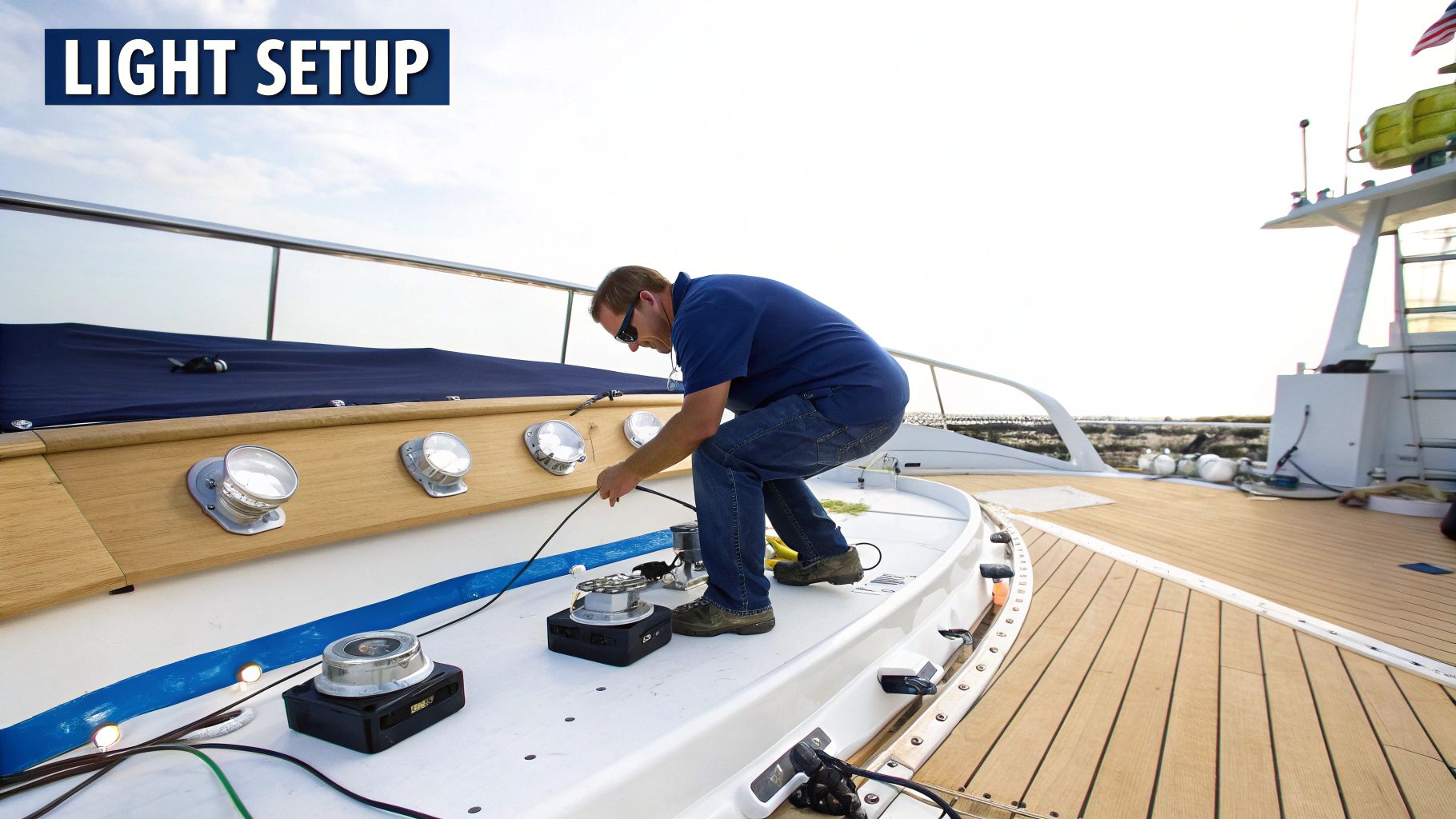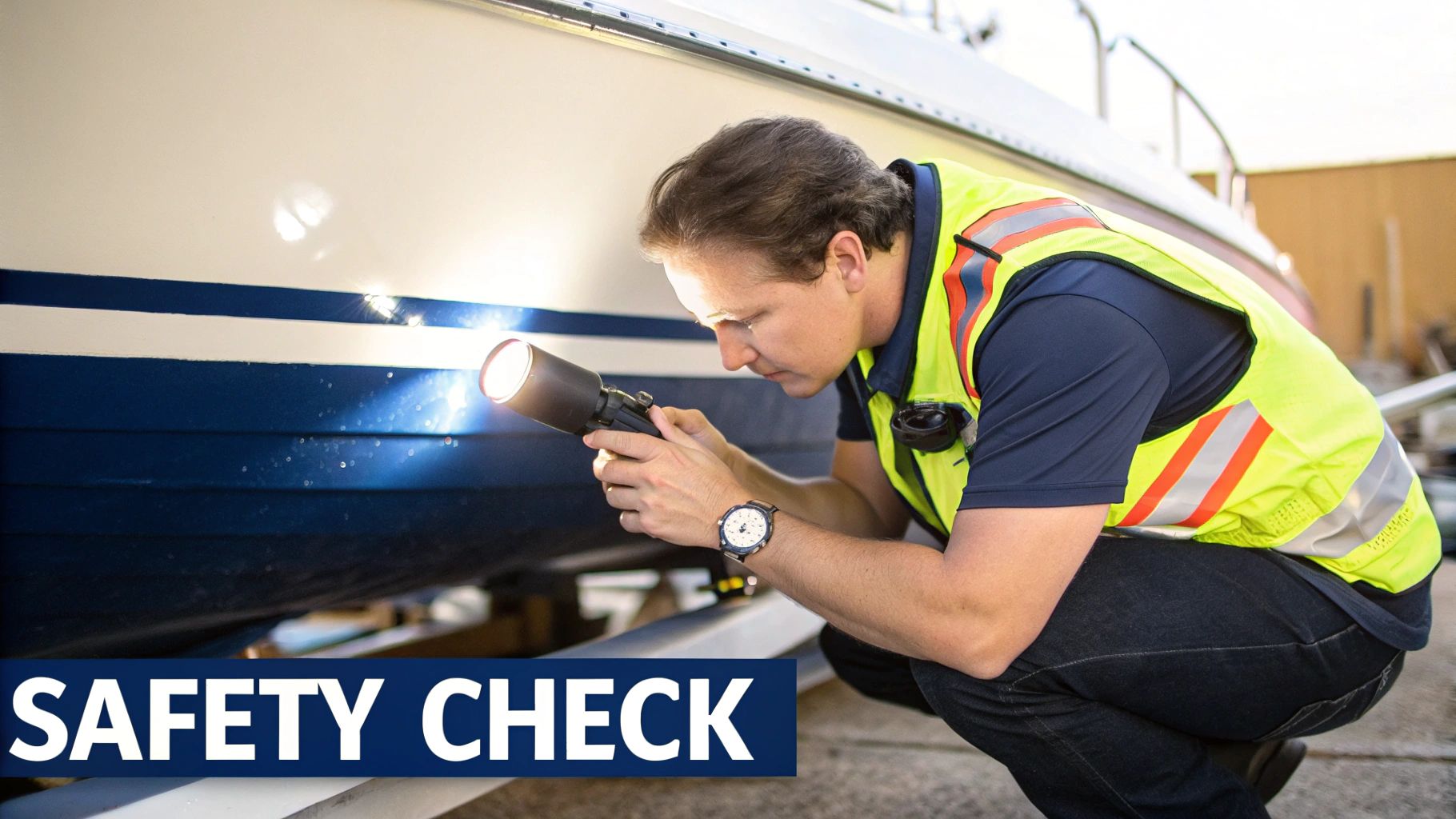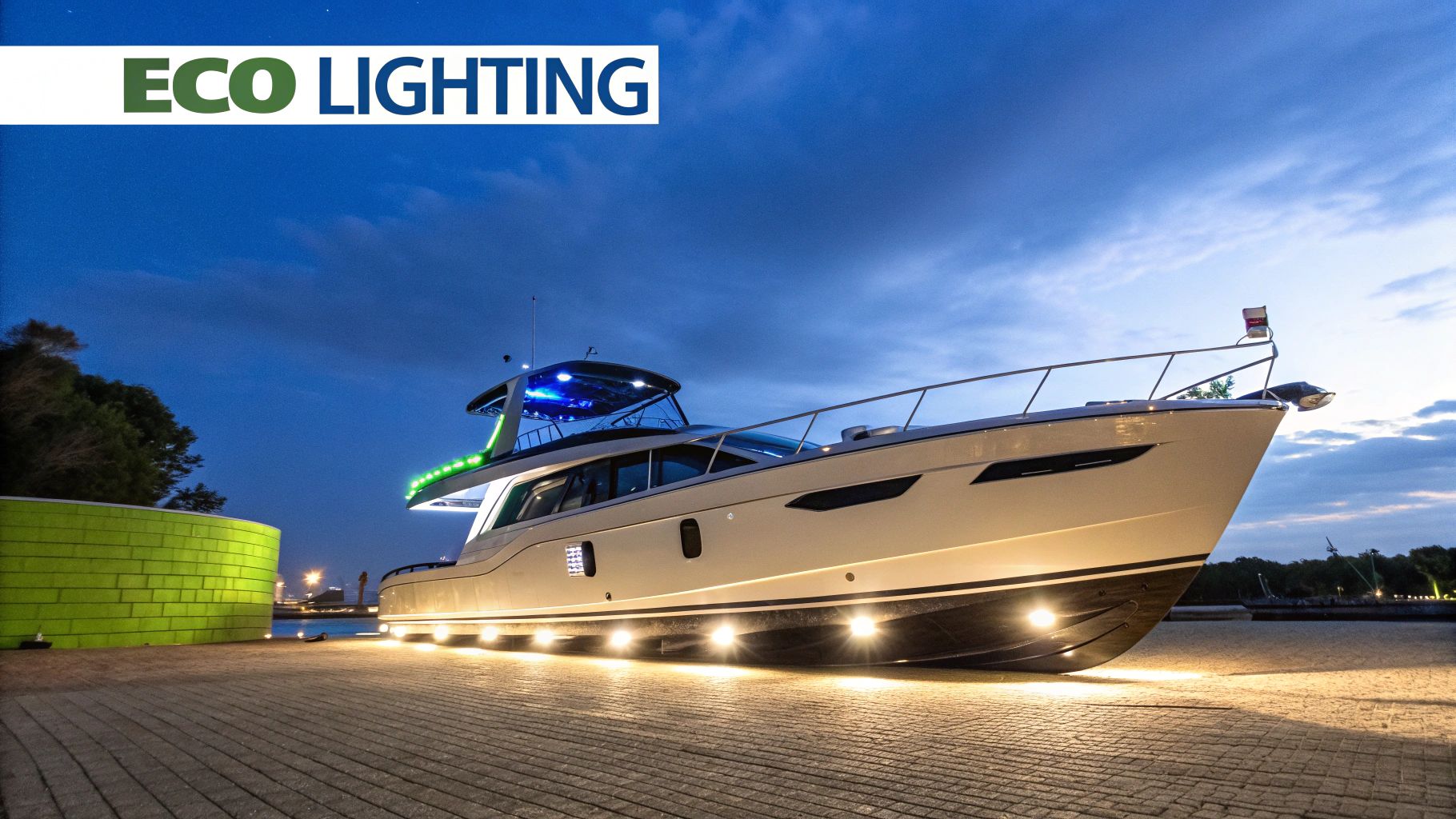The Evolution of Maritime Lighting: From Ancient to Modern

Long before the convenience of electricity, sailors recognized the vital importance of seeing at night. Basic tools like torches and lanterns became early forms of maritime lighting. These simple signals helped prevent collisions in the darkness. These initial attempts, though basic, formed the basis for today's complex boat light regulations. It all highlights a continuous goal: the pursuit of safer navigation.
The history of navigation lights on boats is a long and interesting one, reaching back to ancient maritime laws. The first recorded requirement for ships to display lights appears in the Rhodian Laws. These date back to around the 3rd or 2nd century B.C. Later, around A.D. 161, these laws were incorporated into Roman Law. The goal was to prevent accidents between moving ships and others at anchor or stationary. Explore this topic further
Over the years, rules changed significantly. The 1848 British Admiralty rules were a major development. These rules made red and green sidelights, along with a white masthead light, mandatory for steam ships. These early regulations established the foundation for modern navigation light systems. They emphasized the importance of visibility at sea in preventing accidents.
From Oil Lamps to LEDs: A Technological Leap
The 19th century brought major changes to maritime lighting technology. Oil lamps, and later electric lights, greatly improved visibility and range. This era also saw the standardization of colored navigation lights. Red lights were used for the port (left) side, green for starboard (right), and white for the stern and masthead. This standardization emerged after a series of tragic collisions. It became vital for both accident prevention and establishing a common language of the sea. These improvements fundamentally changed how ships signaled their position and intentions at night.
The Impact of Steam Power
The increasing use of steam-powered ships in the 19th century demanded more stringent boat light regulations. Steam ships were faster and more common than sailing ships. This created a higher risk of collisions. As a result, specific rules were developed for these vessels. These included requirements for masthead lights and distinct sidelights. These rules helped to clearly distinguish steam ships from other vessels on increasingly busy waterways, thus improving safety. These early regulations had a direct influence on the international standards we use today.
Modern Lighting and Future Innovations
The following table summarizes the key milestones in the development of boat light regulations.
To understand the progression of maritime lighting regulations, let's look at a timeline of significant advancements:
Historical Development of Boat Light Regulations
| Time Period | Regulation/Development | Key Features |
|---|---|---|
| 3rd/2nd Century B.C. | Rhodian Laws | Earliest known requirement for ships to carry lights |
| A.D. 161 | Incorporation into Roman Law | Adoption of Rhodian Laws into Roman legal system |
| 1848 | British Admiralty Rules | Mandated red and green sidelights and a white masthead light for steam vessels |
| 19th Century | Standardization of Colored Lights | Red for port, green for starboard, white for stern and masthead |
| 20th Century - Present | International and Inland Regulations | Specific requirements for light type, color, placement, and visibility |
This table highlights the long history and continuous development of maritime lighting regulations, moving from basic collision avoidance to the complex systems we have today.
Today's boat light requirements are set by both international and inland regulations. These rules specify the type, color, placement, and visibility of lights. The requirements vary for different vessel types and operational conditions. This detailed framework creates a consistent system for all ships. It promotes safer navigation worldwide. Ongoing developments in LED technology promise even brighter, more efficient, and durable navigation lights, further improving safety at sea. These innovations build on centuries of maritime tradition, adapting to current technology while upholding the importance of clear and consistent boat lighting.
Navigation Light Requirements By Vessel Type

Understanding boat light requirements is crucial for safe navigation. Different vessels have specific lighting configurations for communicating vital information about their size, direction, and activity to other boats. This shared language of lights helps prevent collisions and ensures safe passage for everyone on the water.
Powerboats Under 12 Meters
Powerboats under 12 meters (approximately 39.4 feet) have a straightforward lighting system. They need an all-around white light, visible from 360 degrees. This single light combines the functions of a masthead light and a stern light.
In addition to the all-around white light, these smaller powerboats also require sidelights. A red light on the port (left) side and a green light on the starboard (right) side indicate the boat's direction of travel, a critical piece of information, especially at night.
Sailboats Under Sail
Sailboats under sail have slightly different requirements. While they also display sidelights, a tricolor light at the masthead can replace separate masthead and stern lights. This single fixture emits red, green, and white light sectors, instantly signaling that the vessel is under sail.
This clear visual distinction between sailboats and power-driven vessels enhances communication and safety. It’s important to note that sailboats can also display separate sidelights, a stern light, and a masthead light if preferred.
Larger Vessels (Over 12 Meters)
Lighting requirements become more complex as vessel size increases. Boats between 12 and 20 meters (39.4 to 65.6 feet) need separate sidelights, a stern light, and a masthead light when under power.
Vessels over 20 meters (65.6 feet) have even more demanding requirements. These often include two masthead lights – one forward and one aft. The specific placement and visibility range of these lights become more stringent due to the maneuvering limitations of larger vessels. They need to provide ample warning to other boaters.
To help summarize the different lighting requirements, take a look at the table below:
Navigation Light Requirements By Vessel Type Comprehensive comparison of required lights for different vessel categories
| Vessel Type | Required Lights | Positioning | Visibility Range |
|---|---|---|---|
| Powerboats Under 12 Meters | All-around white light, sidelights (red/green) | White light visible 360°; sidelights on port/starboard | Varies by light type |
| Sailboats Under Sail | Sidelights, tricolor light (or separate masthead/stern light) | Sidelights on port/starboard; tricolor/masthead light at top of mast | Varies by light type |
| Vessels 12-20 Meters | Sidelights, stern light, masthead light | Sidelights on port/starboard; stern light aft; masthead light forward | Varies by light type, generally increases with vessel length |
| Vessels Over 20 Meters | Sidelights, two masthead lights, stern light | Sidelights on port/starboard; stern light aft; masthead lights forward and aft | Varies by light type, generally the longest ranges required |
The table provides a clear overview of the lights required for each vessel type, emphasizing the increased complexity for larger boats. This highlights the importance of understanding your vessel's specific needs.
Navigation Light Visibility and Positioning
The visibility range of navigation lights is also critical. Sidelights must typically be visible for at least two nautical miles. Masthead and stern lights have varying ranges depending on vessel length.
Correct positioning is essential for maximum visibility. Sidelights should be positioned as far forward and outboard as possible to ensure they are seen from the widest possible angles, especially in low visibility conditions. You can learn more in our guide on How to master boat lighting configurations.
A Brief History of Navigation Lights
Interestingly, navigation light regulations have evolved over time. As early as 1838, the United States required steamboats to carry lights at night. The UK's Steam Navigation Act of 1846 and the British Admiralty's 1848 regulations further standardized lighting, including requirements for sidelights and masthead lights. Learn more about navigation light history.
Understanding and adhering to navigation light requirements is fundamental to safe boating. By displaying the correct lights and ensuring their proper function and visibility, boaters contribute to a safer and more predictable maritime environment for everyone.
Mastering Anchor Light Requirements For Safety

Proper anchor lighting is essential for boat safety, yet often overlooked. Even experienced boaters sometimes miss this critical detail. This seemingly minor requirement can be the difference between a peaceful night and a dangerous collision. Understanding these regulations protects you and those around you.
Understanding the Basics of Anchor Lights
The main purpose of an anchor light is to signal your boat's stationary position to other vessels. This is especially important at night, in foggy conditions, or crowded anchorages. Imagine a car stopping on a busy highway without lights – the results could be devastating. A dark, unlit boat at anchor poses a similar danger.
Anchor lights are vital for boating safety, especially at night. The Inland Rules require anchored vessels to display specific lights for visibility. A 360-degree white all-around masthead light with two-mile visibility is typical for most recreational boats. The importance of these lights is underscored by past accidents caused by their absence. Proper lighting not only fulfills regulations but also protects other boats by clearly marking your position. For more information, check out this helpful article on anchor light requirements.
Visibility and Mounting Height: Key Considerations
Your anchor light's visibility range is crucial. Regulations mandate a minimum of two nautical miles, but exceeding this is always a good idea, particularly in high-traffic areas. Greater visibility gives other boaters more time to react and adjust their course, preventing potential accidents.
The height of your anchor light also matters. The higher it is, the further it can be seen. For smaller boats, the highest point is usually sufficient. Larger vessels, however, might need dedicated masthead lights to meet the rules.
Beyond the Basics: Additional Lighting Requirements
While a single all-around white light is standard for most recreational boats, other situations may call for additional lighting. Vessels over 50 meters often require two all-around lights – one at the front and one at the back. This ensures maximum visibility from all directions.
Vessels involved in specific activities, like dredging or underwater operations, might need specialized lights to signal their status. These rules vary based on the activity and navigation regulations. Understanding these specific requirements ensures full compliance and enhances safety.
Navigating International vs. Inland Lighting Regulations

Understanding boat light regulations can feel overwhelming, especially when dealing with the differences between international and inland rules. Knowing which rules apply is crucial for both safety and staying within the law. Displaying the correct lights for your specific location helps prevent accidents and avoids potential fines.
Key Differences Between Regulations
International regulations, commonly known as COLREGs (Collision Regulations), typically apply on the open ocean and connected waters used by seagoing vessels. Inland rules apply to inland waterways, such as rivers, lakes, and some coastal zones. These two sets of rules address the specific challenges and traffic patterns in each environment.
One major difference is the visibility distance required for lights. Both sets of rules specify colors and visibility arcs, but the distances can vary. For example, sidelights might need to be visible for two miles in inland waters, while international rules may require a different range.
Transitioning Between International and Inland Waters
It's essential to know when to switch between these rule sets. This often involves understanding the boundaries of navigable waters and specific lines set by local authorities. Moving from coastal waters into a river, for instance, would require a change from international to inland lighting rules.
These transitions aren't always clearly marked. Consulting nautical charts and local regulations is recommended for all boaters. This proactive approach helps avoid any confusion and ensures you display the right lights as you move.
Specific Lighting Requirements Variations
Some lighting rules vary significantly between international and inland waters. These differences can involve the number, location, and visibility of lights, particularly for specialized boats like fishing vessels or those towing other boats.
One example is the all-around white light. Inland rules might allow smaller boats to display a single all-around white light when anchored, while international rules might require separate masthead and stern lights.
Another difference could relate to lights displayed by vessels not under command or restricted in their ability to maneuver. These signals are essential for communicating a vessel's status and preventing collisions.
Understanding Enforcement and Consequences
Not following the rules can have significant consequences. Violating boat light regulations can result in penalties, such as fines. In accident situations, legal problems could also arise. Following these regulations is key not only for avoiding legal issues but also for creating a safer boating environment.
Practical Scenarios and Geographical Guidance
Imagine boating in a coastal bay. Inside the bay, you'd follow inland rules. However, crossing a designated line into the open ocean triggers the international regulations, meaning you need to adjust your boat's lighting.
Likewise, entering a river from the ocean requires switching from international to inland rules. Being aware of these transition points is vital. Consulting local charts and maritime authorities will help you know where these boundaries are.
Conclusion
Knowing the difference between international and inland boat light requirements is essential for every boater. This knowledge ensures safe navigation and legal compliance, contributing to a safer environment for everyone on the water. Understanding these differences allows you to confidently navigate various waterways, secure in knowing you're following the correct lighting regulations.
Troubleshooting Boat Light Compliance Issues
Even experienced boaters can sometimes have trouble with their boat lights. This can lead to safety risks and even fines. This section covers common installation mistakes, electrical problems, and confusion about regulations that often come up during boat inspections. Understanding these issues can help keep your boat's lighting compliant and working well, making the water safer for everyone.
Common Installation Problems and Solutions
One frequent problem is incorrect light placement. Sidelights, for example, should be mounted as far forward and outward as possible for the best visibility. If placed too close to the centerline or too far back, they won't be as effective. This is especially important in foggy or low-visibility conditions. Similarly, masthead lights must be mounted high enough to meet visibility requirements, which depend on the length of your boat.
Another issue is insufficient visibility range. Sidelights must be visible for at least two nautical miles. Masthead and stern light ranges depend on your boat's size. Using weak lights or having dirty lenses can reduce visibility, making it harder for other boats to see you. Regular cleaning and testing are important to ensure your lights meet the requirements.
Weatherproofing issues can also cause problems. Exposure to sun, wind, and water can corrode connections, damage wiring, and affect how well your lights work. Using marine-grade components and proper sealing techniques is key to preventing these issues. This helps ensure your lights stay reliable all season long.
Electrical System Troubleshooting
Electrical problems can be both annoying and dangerous. A blown fuse or bad wiring can cause your lights to fail completely or partially, making your boat unsafe at night. Understanding basic electrical troubleshooting is a must for any boater.
Here's a simple troubleshooting guide:
- Check the fuse: A blown fuse is often the easiest problem to fix. Keep extra fuses on your boat.
- Inspect the wiring: Look for loose connections, corrosion, or damaged wires. Fix or replace any problems you find.
- Test the light fixture: If the fuse and wiring seem okay, the light itself might be faulty. Test it with a multimeter or try a new bulb.
- Check the switch: A bad switch can prevent the lights from turning on. Test the switch or try replacing it.
Regulatory Misinterpretations and Clarifications
Understanding boat light regulations can be tricky, especially the differences between international and inland rules. A common mistake is using one all-around white light. While this is allowed for smaller boats at anchor under inland rules, international regulations often require separate masthead and stern lights. Knowing which rules apply to where you're boating is essential.
You might be interested in: How to master boat lighting.
Another area of confusion involves lights for vessels restricted in their ability to maneuver. These signals are important for communicating a vessel's status and preventing collisions. Misunderstanding or incorrectly displaying these signals can be dangerous.
Professional Maintenance and Testing
Regular maintenance is essential for reliable lighting. Inspect your lights often, making sure they work correctly, have clean lenses, and have secure wiring. Keeping spare bulbs on board is always a good idea. Also, test your light visibility at night, in fog, and in rain to ensure they meet the requirements and keep you safe. By taking these steps, you can avoid common lighting problems and keep your boat's lights in great shape.
The Future of Boat Lighting: Technology and Trends
The world of boat lighting is evolving, bringing with it new technologies that enhance safety while simultaneously improving energy efficiency and minimizing maintenance. These advancements represent a significant step beyond simply fulfilling the minimum boat light requirements, offering tangible benefits for all boaters.
LED Technology: Brighter, Longer-Lasting, and More Efficient
LED (Light Emitting Diode) technology has transformed boat lighting. LEDs are considerably more energy-efficient than traditional incandescent bulbs, drawing less power from your boat's battery. This is a considerable advantage, especially for longer trips or overnight anchoring. LEDs also boast a significantly longer lifespan, reducing the need for frequent replacements and the associated maintenance. Most importantly, LEDs produce a brighter, more focused light, which greatly improves visibility and safety on the water.
Solar-Powered Lighting: Harnessing the Sun's Energy
Solar-powered boat lights offer a sustainable and convenient alternative, especially for navigation and anchor lights. These systems utilize photovoltaic cells to convert sunlight into electricity, charging onboard batteries that power the lights. This lessens the demand on the boat's primary power system and provides a reliable backup in case of electrical issues. Solar-powered lights are especially beneficial for smaller vessels, sailboats, and boats frequently left at anchor.
Smart Lighting Controls: Automation and Integration
Smart lighting control systems represent a growing trend in boat lighting. These systems offer automated light control, adjusting brightness based on ambient light or turning lights on and off at pre-set times. Some systems even integrate with navigation equipment, automatically activating navigation lights at sunset and dimming them in conditions of reduced visibility such as fog. This automation enhances convenience and reduces the potential for human error in light operation.
Emerging Technologies: Enhancing Visibility and Safety
Beyond LEDs and solar power, other promising developments are shaping the future of boat lighting. Dynamic lighting systems adjust light beam intensity and direction according to changing conditions, optimizing visibility in various environments. Integrated monitoring systems offer real-time feedback on navigation light status, alerting boaters to malfunctions before they escalate into safety hazards. New materials and manufacturing techniques are also leading to more durable and weather-resistant lights, increasing lifespan and reducing maintenance. See our guide on How to Master Boat Lighting Configurations.
Regulatory Adaptation: Balancing Innovation and Safety
As boat lighting technology progresses, regulatory bodies are adapting standards to these changes while upholding essential safety principles for collision prevention. This involves updating regulations to reflect the performance of new light sources like LEDs and incorporating provisions for emerging technologies such as smart lighting controls. This ongoing process ensures boat light requirements continue to prioritize safety while encouraging innovation in the maritime industry.
Upgrade your fueling process with the reliability and environmental consciousness of CLiX Fueling Solutions. Visit https://clixfueling.com to discover our spill-free, automated fueling system and how it can simplify your boating experience.











